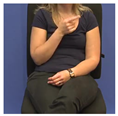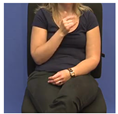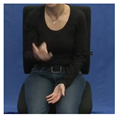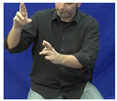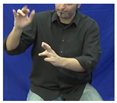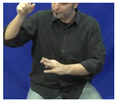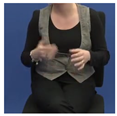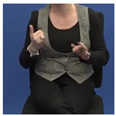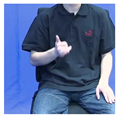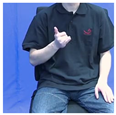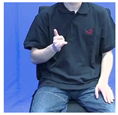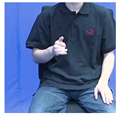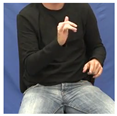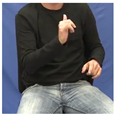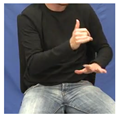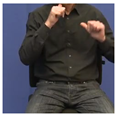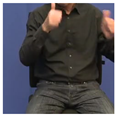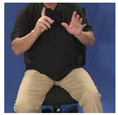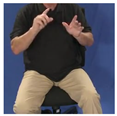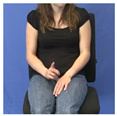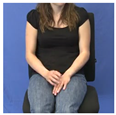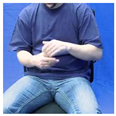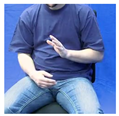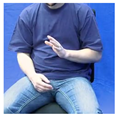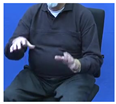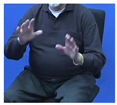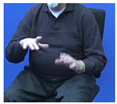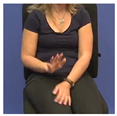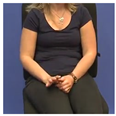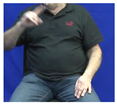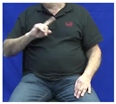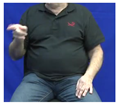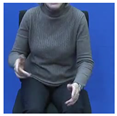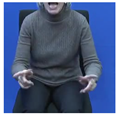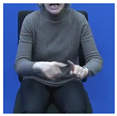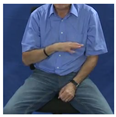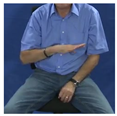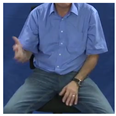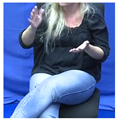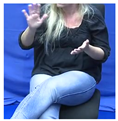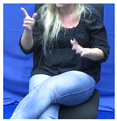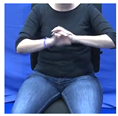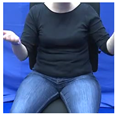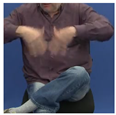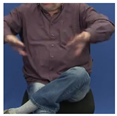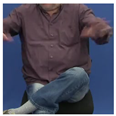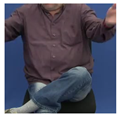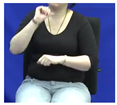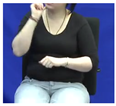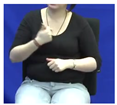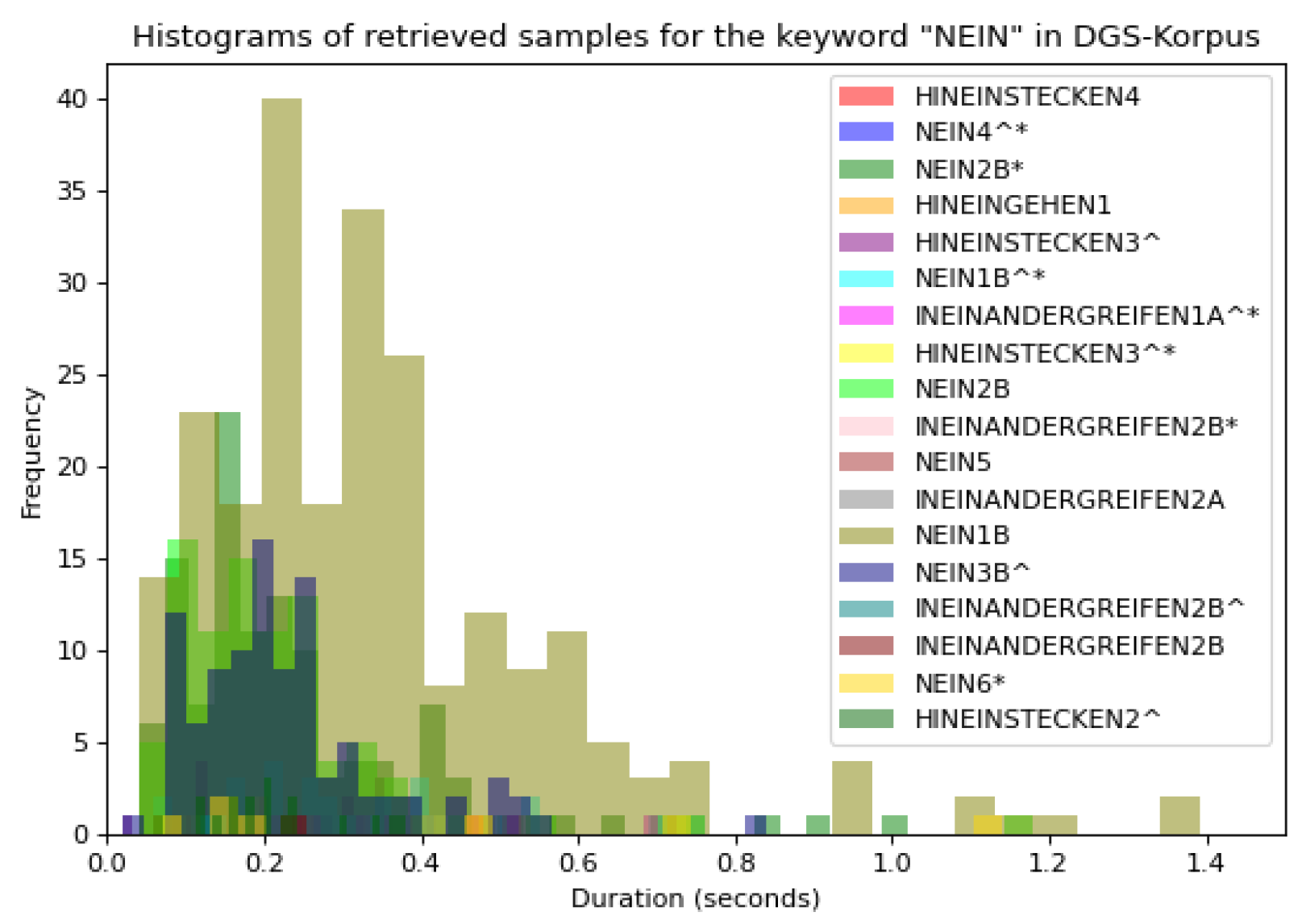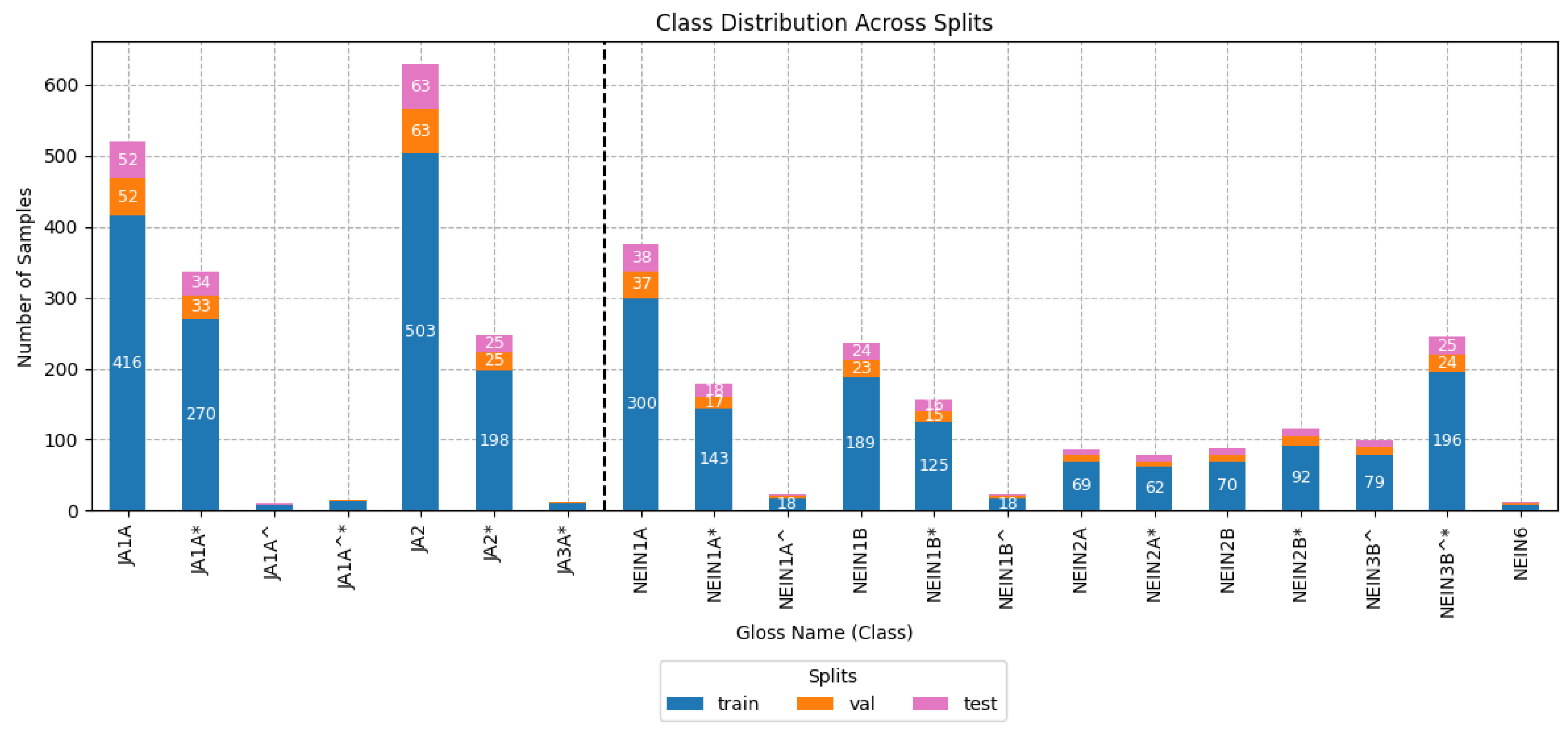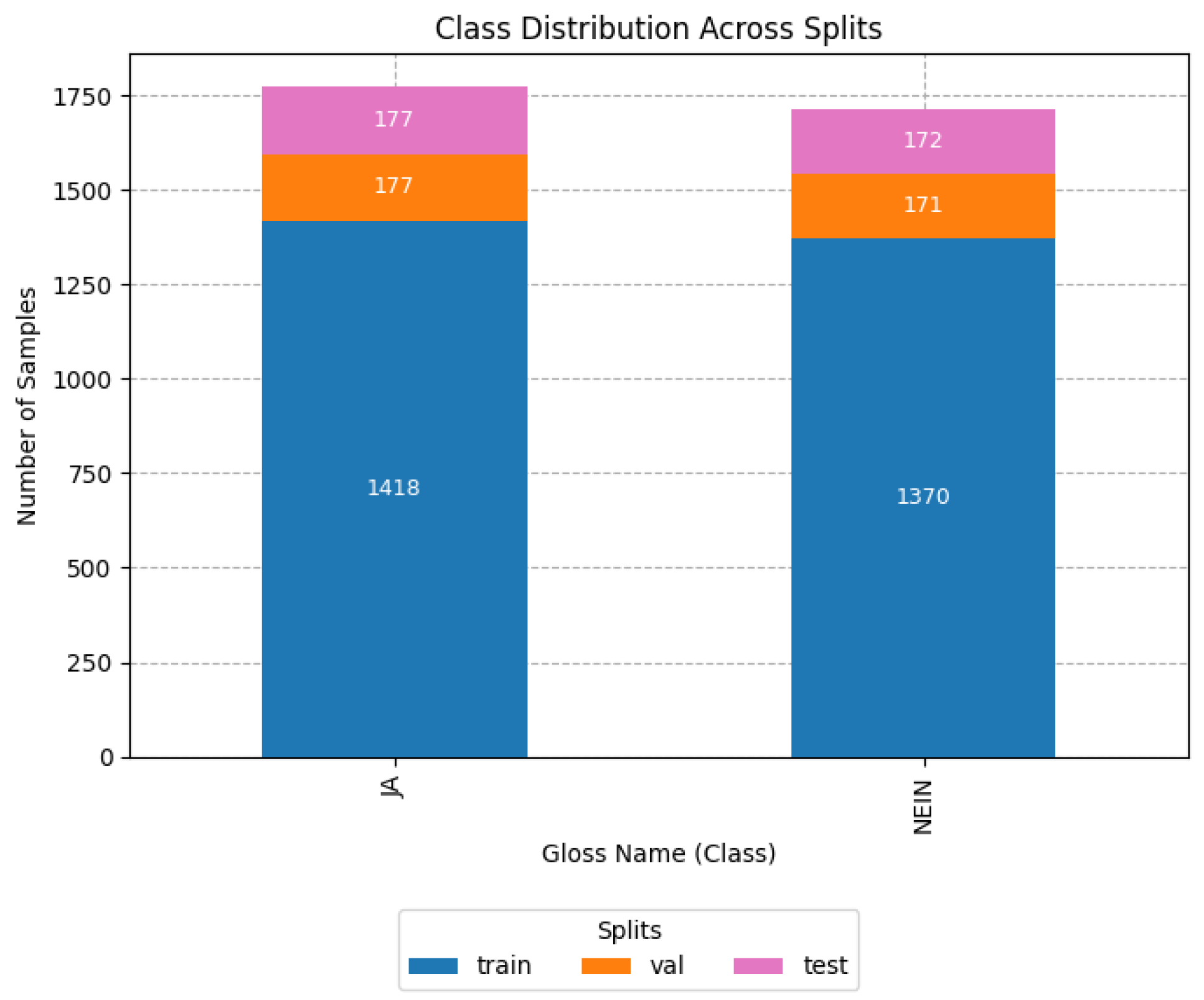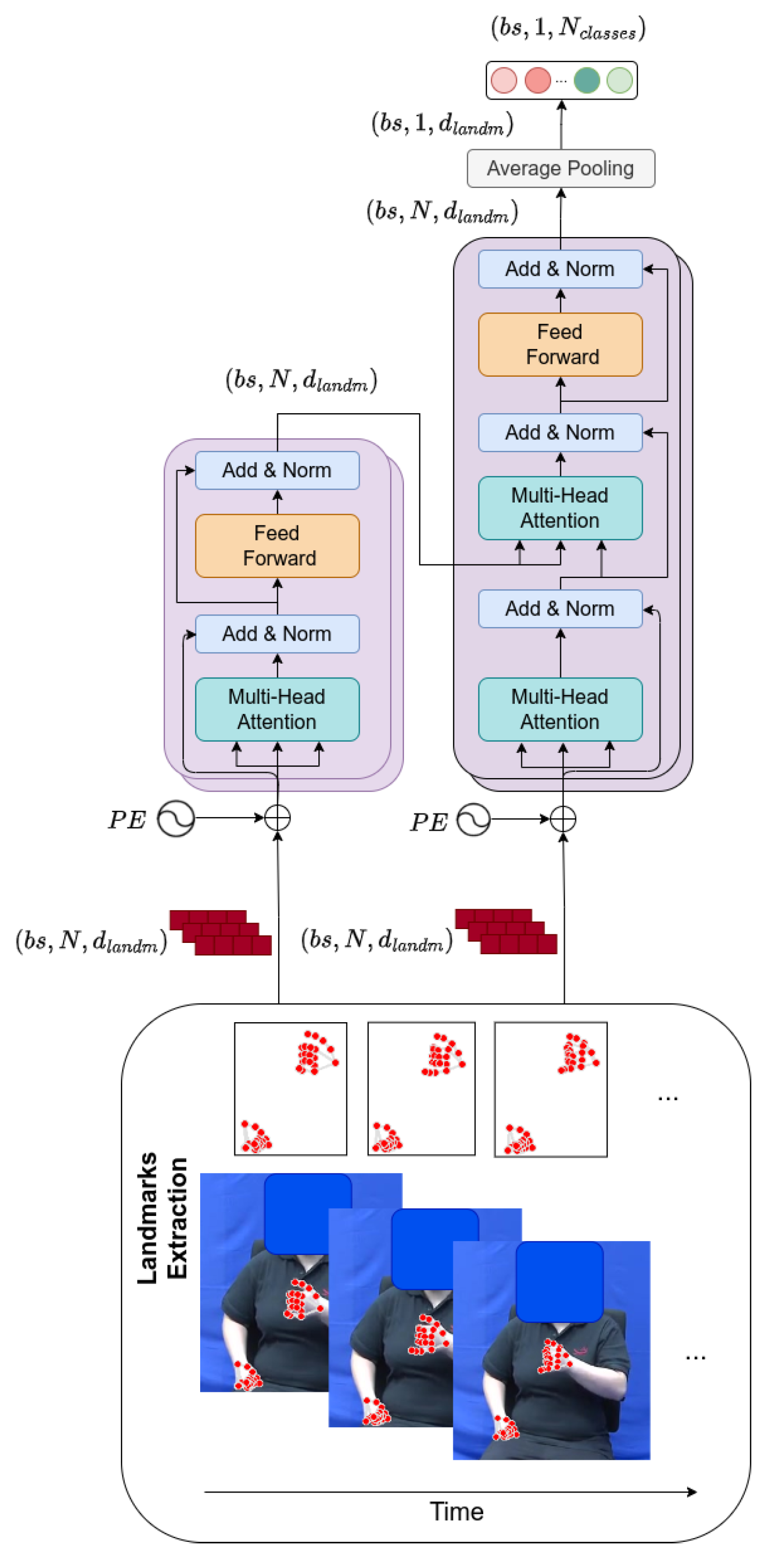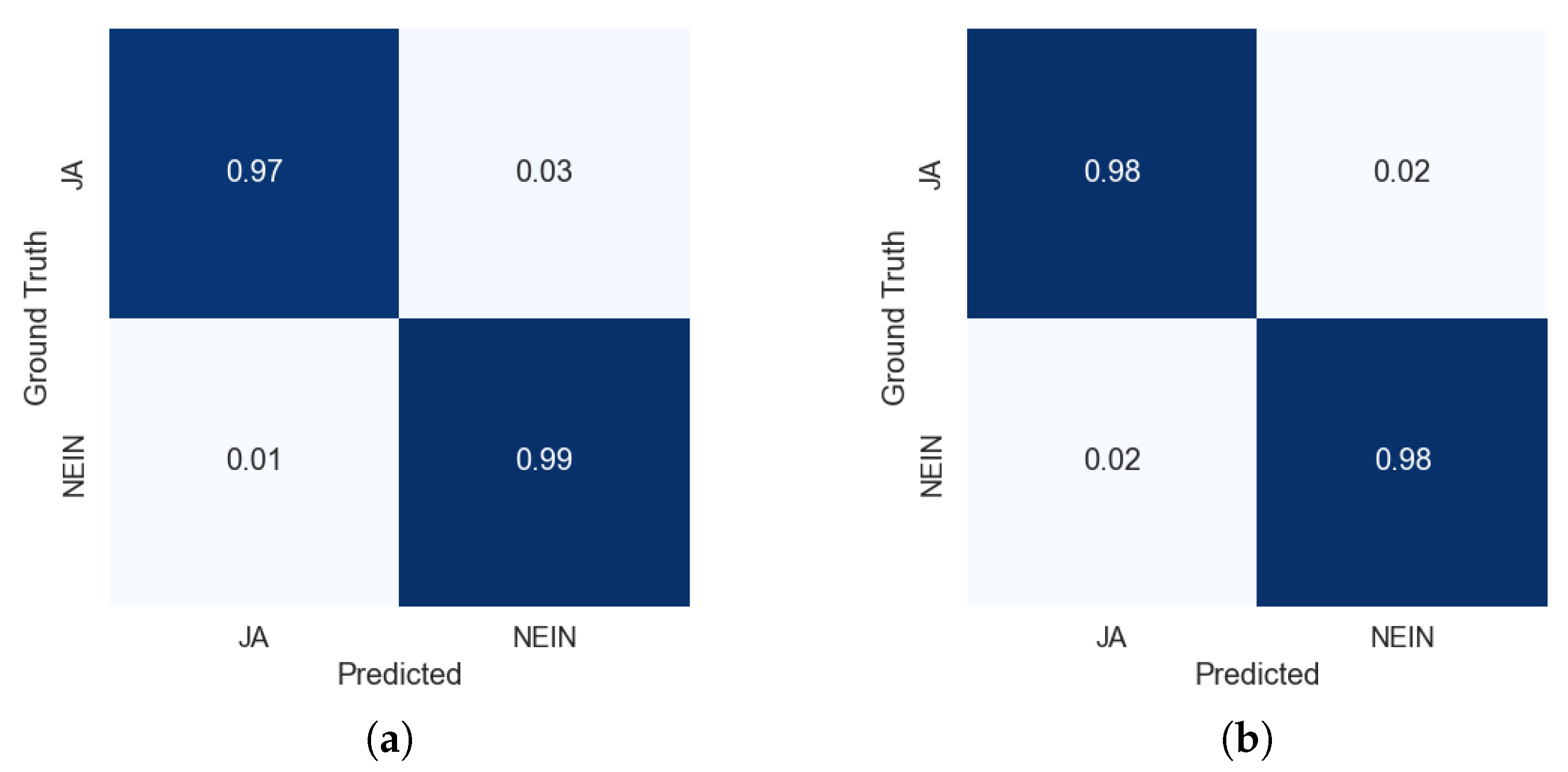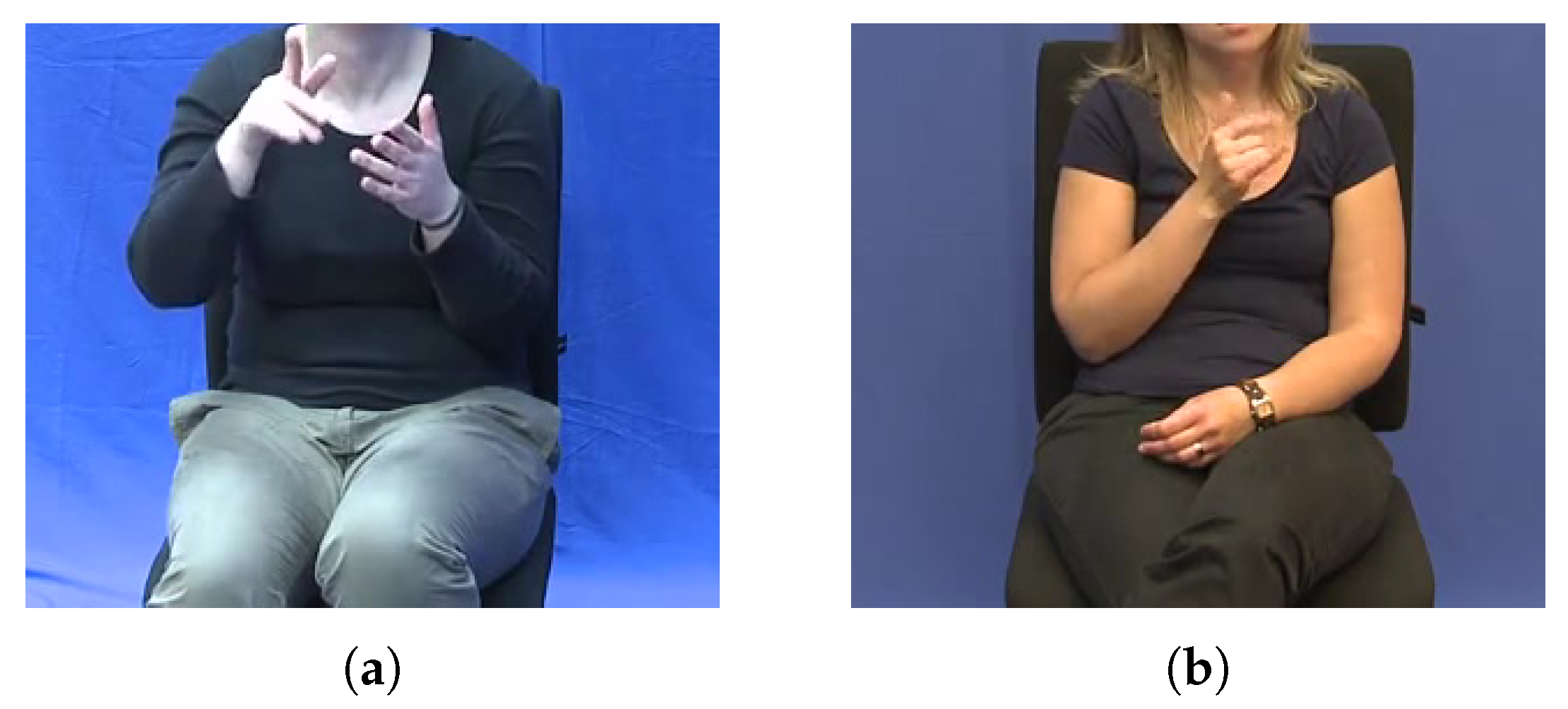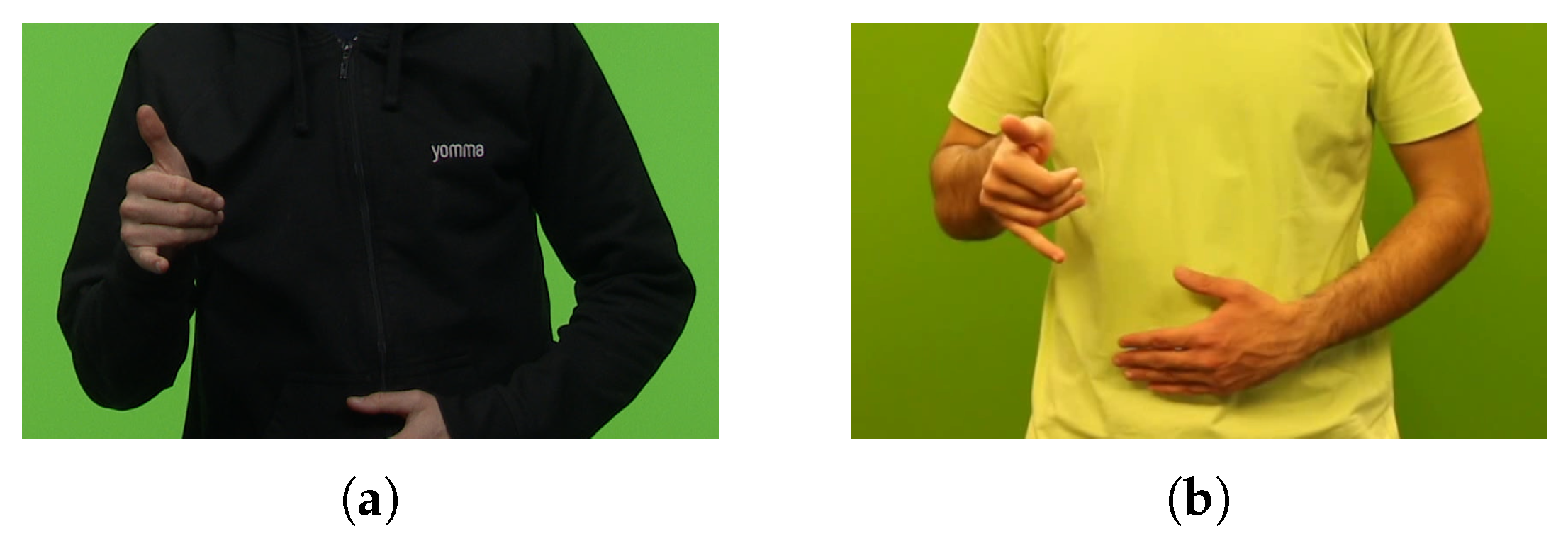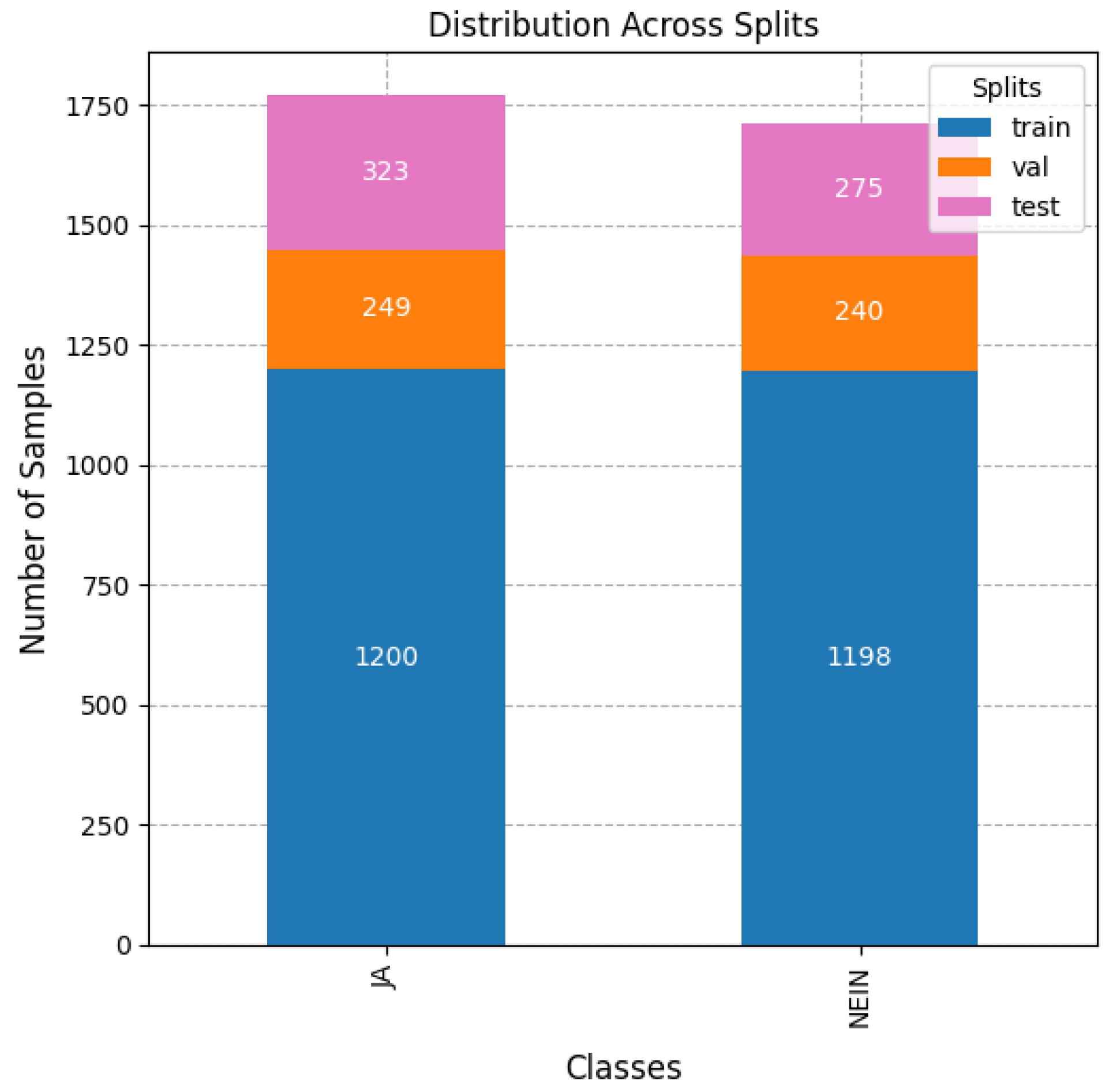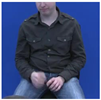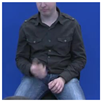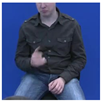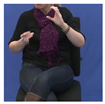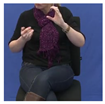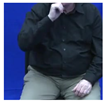In this section, we first present the datasets available to the research community for Sign Language recognition or translation, specially focusing on DGS. We then provide an overview of the evolution of the employed models in the literature from CNNs to transformers, with a particular emphasis on the task of ISLR.
2.1. Datasets for Sign Language Recognition/Translation
The development of robust systems for Sign Language recognition (SLR) and Sign Language translation (SLT) critically depends on the availability of high-quality datasets. Over the past decades, several corpora have been created to document and support computational research across a variety of Sign Languages, such as American Sign Language (ASL), British Sign Language (BSL), and German Sign Language (DGS), among others. For example, in Chinese Sign Language (CSL), the CSL-Daily dataset [
4] is a reference dataset for performing continuous Chinese Sign Language translation and recognition, focusing on natural daily life scenarios such as travel, shopping, and medical care. The dataset contains 20,654 videos with a total duration of approximately 23.27 h recorded in a lab-controlled environment. In American Sign Language (ASL), WLASL [
5] and MS-ASL [
6] have been frequently employed as benchmarks for ISLR. The first, WLASL, contains over 21,000 video samples covering 2000 different common ASL glosses performed by more than 100 signers. One of the disadvantages of this dataset is that it was collected from the web, which results in different signs assigned to the same label, making the predictions challenging for the models. The second, MS-ASL, contains approximately 25,000 annotated video samples of 1000 distinct ASL signs performed by more than 200 different signers. How2Sign [
7] is a more recent example of a released dataset for research in ASL. It consists of over 80 h of multimodal and multiview videos recorded by native signers and professional interpreters, aiming to support research on Sign Language recognition, translation, and production with a focus on instructional resources.
In the line of generating more resources in SL, efforts have also been invested to study differences between Sign Languages, resulting in several collections of datasets such as the ECHO corpus [
8]. Among its recordings, this corpus contains videos of lexical elicitation and annotated segments of dialogue, poetry, and fairy tale narrations. This dataset was created to pursue ‘comparative studies of European Sign Languages’. For this reason, and despite the challenges of collecting data from minorities, including different dialects and languages, they acquired recordings in German Sign Language (DGS), British Sign Language (BSL), Dutch Sign Language (NGT), and Swedish Sign Language (SSL).
Nonetheless and despite the large amount of resources in different languages, when focusing on research in specific scenarios, tasks (e.g., ISLR versus CSLT), and applications, the amount of available resources is narrowed. Specifically and focusing on the Sign Language addressed in this article, DGS, there exist counted datasets available that have been employed mainly with research purposes. Two of the most employed benchmark datasets for statistical DGS Sign Language recognition and translation are RWTH-PHOENIX and RWTH-PHOENIX-Weather2014T [
9,
10]. They consist of video recordings of Sign Language interpreters presenting the daily weather forecast from the German public TV station PHOENIX. Although these datasets contain valuable information, their vocabulary is limited to the weather domain. Additionally, its annotations cannot be directly employed for ISLR without a prior alignment step, since they lack temporal annotations of the start and ending time of each gloss.
SIGNUM [
11] is another dataset containing signs and annotations for studying DGS recognition and translation. It contains both isolated signs and continuous sentences performed by native DGS signers. The vocabulary includes 450 basic signs, from which 780 sentences were constructed with different lengths ranging from 2 to 11 signs. The entire corpus was performed by 25 native signers (23 right-handed and 2 left-handed signers) varying in ages, genders, and signing styles. The data were recorded under controlled laboratory conditions as sequences of images (frames), with a total of more than 33,000 sequences and nearly 6 million images, which amounts to about 55 h of video data at a resolution of 776 × 578 pixels and 30 frames per second. More recently, the AVASAG dataset [
12,
13] was developed with the aim of covering daily life traveling situations. It was annotated with German texts and glosses for research purposes in ISLR and CSLT. Unlike previous datasets, this dataset contains motion tracking data for enhancing research in Sign Language production with avatars. Overall, AVASAG contains a collection of 312 videos of sentences recorded at a resolution of 1920 × 1080 pixels at 60 frames per second, with a total duration of 96.05 min.
Despite the variability of datasets, they are normally limited in the covered vocabulary, context, and domains, which reduces the possibilities of developing recognizers focusing on certain scenarios. Moreover, the glosses’ annotation scheme also changes from one dataset to another. For this reason, the DGS-Korpus project [
14] aimed to create a comprehensive corpus with samples of dialogue on everyday situations collected from native DGS signers across Germany. In order to handle different variations and study them from a linguistic perspective, guidelines and standards were created to annotate videos, resulting in one of the largest corpora available for researching DGS from a linguistic perspective. More specifically, the DGS-Korpus [
15] contains in total approximately 50 h of video material annotated in terms of Sign Language linguistic features, such as the dominant hand, the specific mouthing that accompanies each sign, and the glosses and text annotations in German and English. Additionally, pose features are also provided to allow pose comparisons and analysis. From the annotations’ perspective, one of the most relevant contributions is their gloss annotation standard [
16], especially the double-glossing procedure. According to this annotation scheme, there exists a differentiation between gloss types and glosses (or subtypes), which are specified by a citation form. Subtypes stand for additional core meaning aspects, in which normally the sign is accompanied by mouthing that carries the difference in meaning. These subtypes also represent conventionalized form–meaning relations, inheriting the iconic value and citation form from their parent type. In this manner, gloss types are best at expressing a hint to the iconic value of the sign, whereas subtype glosses express a core meaning aspect, containing a larger spectrum of annotated variations. Gloss types and subtypes follow a hierarchical parent–child relationship. For example, the gloss (or lexeme) VIELLEICHT1 is a subtype of the gloss type (or sign) UNGEFÄHR1
^ (see an example here:
https://dock.fdm.uni-hamburg.de/meinedgs/?id=cfec7516-8966-44ed-84af-41b3dbc1689e#_q=R2xvc3M9IlZJRUxMRUlDSFQxIg&ql=aql&_c=REdTLUNvcnB1cy1yMy1kZQ&cl=5&cr=5&s=0&l=10&m=0, accessed on 20 September 2025). Hence, all the tokens that belong to VIELLEICHT1 (MAYBE1* gloss in English), also belong to UNGEFÄHR1
^ (APPROXIMATELY1in English).
However, the annotations of glosses and gloss types are not always mutually exclusive, such as for ICH2^ in which the general meaning coincides with the conventionalized meaning, resulting in the same naming for the gloss and the gloss type. As mentioned before, gloss (or lexeme) annotations contain additional variations associated with the production of the sign, such as variations in the dominant hand (represented by ‘||’ for the case of the left hand), numbers to differentiate lexical variants with exchangeable signs in similar contexts, or the asterisk (*) to differentiate those tokens with variations from the type/subtypes.
Although the DGS-Korpus was originally created for linguistic purposes to study the richness and linguistic characteristics of DGS across different dialects and regions, such as in the work of A. Bauer et al. [
17] in which they explore the head nodes in dyadic conversations, differentiating between affirmative nods from feedback nodes, recently, the machine learning community has also shown interest in employing this dataset to evaluate and implement algorithms to improve DGS recognition. However, given the differences between the fields of linguistics and computer science and their final aims, there are still open questions about which are the most beneficial processing steps for this dataset to train accurate machine learning models that could be applied in real-life situations. Some initial approaches are based on selecting random samples of glosses, such as in the article of D. Nam Pham et al. [
18], in which they explore and compare the contribution of facial features (i.e., eyes, mouthing, and the whole face) for enhancing SLR in twelve classes extracted from the DGS-Korpus by employing a MultiScale Visual Transformer (MViT) [
19] and Channel-Separated Convolutional Network (CSN). However, specific applications could require a more semantically accurate selection of samples in order to recognize specific events, such as affirmations or negations.
2.2. Isolated Sign Language Recognition
As we have commented before, the datasets differ in scope, modality, and annotation granularity, ranging from isolated sign collections to large-scale continuous signing corpora. They also vary in the recording modalities employed, including RGB videos, depth data, and pose or landmark annotations. These variations are also mirrored in the methods and models proposed to advance research in ISLR.
Isolated Sign Language Recognition has been tackled using a number of different input modalities, mainly RGB(-D) video or skeleton/pose data [
20]. The first category of methods processes full video frames, while the second relies on landmarks extracted from these frames. Early progress in ISLR based on RGB images largely relied on Convolutional Neural Networks (CNNs). Notable work demonstrated a good recognition accuracy on benchmark datasets, laying the foundation for automated Sign Language understanding. This is the case for the I3D architecture, which is based on a 3D ConvNet (I3D) with an inflated-inception CNN, that was originally proposed for action recognition, improving approaches based on 2D CNNs combined with LSTMs [
21]. This architecture was subsequently adapted to Sign Language recognition, such as for British Sign Language (BSL) [
22], Azerbaijani Sign Language (AzSL) [
23], or others [
24]. J. Huang and V. Chouvatut [
25] also proposed an architecture based on CNNs. In their article, they combined a 3D ResNet and a Bidirectional Long Short Term Memory (Bi-LSTM) network, encoding short-term visual and movement characteristics first, and then interpreting these extracted spatial features using a Bi-LSTM, to introduce the temporal dimension. With this approach, they achieved state-of-the-art results on the LSA64 [
26] dataset.
However, CNNs inherently focus on a local spatial context through fixed receptive fields and often struggle to capture long-range spatial and temporal dependencies in images and video. These limitations restricted the ability to fully model complex spatiotemporal patterns. As a consequence, in recent years, there has been a shift towards landmark-based approaches [
20] employing sequential models. Using landmark-based approaches provides multiple advantages, starting with their low computational latency, compactness of features, and robustness to variations in background, lighting, and appearance, as well as suitability for real-time applications. Additionally, the skeleton data can easily be extracted from RGB video using widely available models [
27,
28] and frameworks like MediaPipe [
29], Yolov8 [
30], or OpenPose [
31]. This is mainly the reason why they have also been employed in several applications in the literature, from sports analytics, converting 2D representations into 3D meshes [
32] to Sign Language Recognition [
33,
34]. In this family of proposals relying on landmarks (or keypoints), there exist methods based on traditional sequential models (i.e., LSTMs), in which, for example, landmarks extracted from YOLOv8 and optical flow are introduced into a Bi-LSTM to perform Kazakh Sign Language Recognition of 2, 13, and 47 glosses [
35].
Nonetheless, RNNs, while capable of temporal modeling, suffer from issues like vanishing gradients and are difficult to parallelize for efficient training. For this reason, transformer-based methods have recently emerged as the dominant approach in the field. Transformers bring intrinsic parallelism during training and show superior generalization, especially on larger datasets. For example, M. Sandoval-Castaneda [
33] compared a baseline I3D with four families of video transformers: VideoMAE (a video transformer that learns pixel reconstructions), SVT (a DINO model pre-trained for videos), BEVT (a BERT model pretrained for videos), and MaskFeat (a multiscale vision transformers for masked reconstructions of Histogram Oriented Gradients). In these experiments, they observed that the MaskFeat model surpassed the I3D model pre-trained on BSL for the WLASL2000 dataset, where the MViTv2 is adapted in a first stage of self-supervised learning using the Kinetics400 dataset for action recognition, and then in a second stage with OpenASL, which in the end requires large amounts of training data.
In cases where available resources are limited, a series of light transformers has been proposed too. Initially, the SPOTER [
36] architecture was released for performing ISLR in WLASL and LSA64. The main variation of SPOTER over regular transformers is that the decoder receives a one-dimensional query vector, learning projections across the temporal representations generated at the output of the encoder. As a continuation of these transformer-based explorations, different pooling strategies for combining the sequential outputs at the decoder of the transformer models were evaluated in [
37] for SLR across two Sign Languages, ASL (with WLASL dataset) and DGS (with the AVASAG dataset).
Other interesting approaches addressed the input features to be introduced into transformers for accomplishing ISLR. M. Pu et al. [
38] designed a new approach for efficient skeleton-based ISLR. They introduce a kinematic hand pose rectification method, enforcing constraints on hand point angles. Additionally, the proposal incorporates an input-adaptive inference mechanism that dynamically adjusts computational paths for different sign gloss complexities. With this approach, their proposals achieve state-of-the-art scores, outperforming previous CNN + LSTM methods on a number of ISLR benchmarks such as the WLASL100 [
5] and LSA64 datasets.
To conclude, although in the literature several works have addressed and worked before in ISLR employing landmarks versus RGB images, or CNNs versus transformers-based approaches, there is still a gap in addressing real-world applications and specific vocabulary to recognize particular scenarios. In this work, we address the problem of recognizing answers to closed-ended questions with transformer models under low-resource scenarios. Being able to recognize variations in signing when answering these types of questions opens the opportunity to embed these models in any real-world dyadic human–computer interaction.


